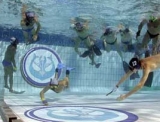About Underwater Hockey
The British Navy invented underwater hockey in the 1950's to keep their divers fit and to improve their ability to move and work efficiently under water. The game came to Australia shortly after and has evolved into a fast, dynamic sport, played in more than 20 countries. Underwater hockey is played in a 25m x 15m pool that is between 2 - 4 m deep.
The game consists of 15 minutes halves and a three minutes half time. Each team is allowed one 60 seconds time out per half. The game clock stops for any infringements in the lasr 2 minutes of the game.
Each side has 12 players, 10 of who can play in any one game. During the game 6 players are in the pool with 4 interchange players on the side who can sub at any time. The players wear large fins, a diving mask and snorkel and a thick glove made from latex to protect the hand from the pool bottom and the puck. The top players can flick the puck well over 3m and it comes off the bottom enough to go over another player.
The puck is made of lead and is coated with plastic, it weighs about 1.5 kg.
The teams start at each end of the pool with one hand on the wall. The puck is in the middle of the pool. When the referee souds the buzzer both teams race to get possession of the puck. There is a goal tray at each end of the playing area; it is 3m long with a slope from the front into a shallow trough at the back wall. The puck must pass through the goal volume for a team to score the goal.
There are many team configurations but generally a team has 3 forwards; a strike and 2 wings and 3 backs; 2 half backs and a full back. The idea is to keep possession of the puck and outwit your opponents by using skill, speed, manoeuvrability and breathe hold.
The rules of Underwater Hockey are fairly simple. Basically it is a non contact sport, a player cannot interfere with another player with their free hand. There is no off side rule howevre shepherding and obstruction is not allowed. The puck must not rest on the glove or be carried on top of the bat or stopped deliberately by anything other than the bat.
Any infringement of the rules is judged by the 2 in water Referees who signal to the out of water referre to sound the buzzer to stop play. Depending on the seriousness of the foul the Referees can award a free puck giving a 3m advantage to the disadvantaged team or can eject players for 1or 2 minutes or for the reminder of the game. If a foul has stopped a certain goal with 3m of the goal then the Referees can award a penalty 2 on 1, or just award a penalty goal.
The competitions in Underwater Hockey range for club to National to World titles. Every 2 years a World Championship is held around April or May. Every other year Australia, New Zealand and South Africa compete in a Tri - Nations cup. There are under 19 years teams, open men's and women's teams and masters teams (over 35 for men and over 32 for women).
Underwater Hockey is a great sport for all ages, shapes and sizes. Quite a few of us have been playing for well over 10 years. It is a sport that does not cause the injuries from running, stopping suddenly or being run into! Mets face it, you can't fall down. It is a sport that continues to grow and which keeps it players interested. Each game is different, each player must overcome their opponent, moving in water, controlling the ouck and the innate need to breathe. Teamwork and anticipation is essential an d al ot of communication goes before and after the games.
The game is 3D, how you play is only limited by your imagination.

























